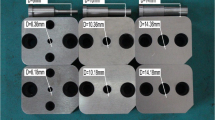Abstract
Sheet metal bending of modern lightweight materials like high-strength low-alloyed steels (HSLA) is one major challenge in metal forming, because conventional methods of predicting failure in numerical simulation, like the forming limit diagram (FLD), can generally not be applied to bending processes. Furthermore, the damage and failure behaviour of HSLA steels are changing as the fracture mechanisms are mainly depending on the microstructure, which is very fine-grained in HSLA steels composed with different alloying elements compared to established mild steels. Especially for high gradients of strain and stress over the sheet thickness, as they occur in small curvature bending processes, other damage models than the FLD have to be utilised. Within this paper a finite element (FE) 3D model of small curvature bending processes is created. The model includes continuum damage mechanics model in order to predict and study occurring failure by means of ductile coherence loss of the material and crack formation with respect to influencing process parameters. Damage parameters are determined by inverse numerical identification method. The FE-model is strain based validated considering the deformation field at the outer bending edge of the specimen by using an optical strain measurement system. The Lemaitre based damage model is calibrated against the experimental results within metallographic analysis adapting the identified damage parameters to the bending process und thus adjusting the crack occurrence in experiment and simulation. Using this model the bendability of common HSLA steel, used for structural components, is evaluated with respect to occurring damage and failure by numerical analysis.










Similar content being viewed by others
References
Akeret R (1978) Failure mechanisms in the bending of aluminum sheets and limits of bendability. Aluminium 54(2):117–123
Schleich R, Sindel M, Liewald M (2009) Investigation on the effect of curvature on forming limit prediction for aluminium sheet alloys. Int J Mater Form 2(2):69–74
Gharbi M, Labergere C, Badreddine H, Soyarslan C, Weinrich A, Hermes M, Chatti S, Sulaiman H, Saanouni K, Tekkaya AE (2011) Advanced experimental–numerical investigations of cold bending of high strength steels. Steel research international: Special Edition: 10th International Conference on Technology of Plasticity, pp 877–883
Hezler C, Tsoupis I, Merklein M, Kasparbauer M (2012) Experimental determination of stress limit curves—comparison of applied technological tests and stamped components by fractographic examinations. In: Proceedings of 5th forming technology forum 2012, pp 87–92
Kaupper M, Tsoupis I, Merklein M, Weidinger P (2011) Characterization of damage and fracture of high strength steels within air bending. In: Proceedings of 6th international conference and exhibition on design and production of machines and dies/molds, pp 71–76
Helms R, Naseband K (1977) Theoretische und experimentelle Untersuchungen zum Mechanismus des duktilen Bruches metallischer Werkstoffe. Arch Eisenhüttenwesen 48(5):297–302
Lemaitre J (1985) A continuous damage mechanics model for ductile fracture. J Eng Mater Technol 107:83–89
Gurson AL (1977) Continuum theory of ductile rupture by void nucleation and growth: part I—yield criteria and flow rules for porous ductile media. J Eng Mater Technol 99:2–15
Niazi MS, Wisselink HH, Meinders T, Huétink J (2012) Failure predictions for DP steel cross-die test using anisotropic damage. Int J Damage Mech 21:713–753
Thuillier S, Le Maoût N, Manach PY (2012) Bending limit prediction of an aluminum thin sheet. Int J Mater Form 3(1):223–226
Hambli R, Mkaddem A, Potiron A (2003) Damage prediction in L-bending processes using FEM. Int J Adv Manuf Technol 22:12–19
Mkaddem A, Hambli R, Potiron A (2004) Comparison between Gurson and Lemaitre damage models in wiping die bending processes. Int J Adv Manuf Technol 23:451–461
Gharbi Malekipour M, Labergère C, Badreddine H, Soyarslan C, Weinrich A, Hermes A. Chatti S, Sulaiman H, Saanouni K, Tekkaya AE (2011) Advanced experimental-numerical investigations of cold bending of high strength steels. Steel Res Int. Special Edition: 10th International Conference on Technology of Plasticity, ICTP2011, pp 877–883
Soyarslan C, Gharbi Malekipour M, Tekkaya AE (2012) A combined experimental-numerical investigation of ductile fracture in bending of a class ferritic-martensitic steel. Int J Plast 49:1608–1626
SEP 1240: Prüf- und Dokumentationsrichtlinie für die experimentelle Ermittlung mechanischer Kennwerte von Feinblech aus Stahl für die CAE-Berechnung. Düsseldorf: Stahleisen Verlag, Ausgabe 7, 2006
DIN EN 10002: Metallische Werkstoffe—Zugversuch, Teil 1: Prüfverfahren (bei Raum-temperatur), Deutsche Fassung EN 10002-1; CEN, Brüssel, 1991
Tsoupis I, Hildering S, Merklein M (2012) Methodology for the analysis of the process behaviour of advanced high strength steels in bending and shearing operations. Key Eng Mater 504–506:895–900
DIN EN ISO 7438:2005: Metallische Werkstoffe—Biegeversuch, Deutsche Fassung EN ISO 7438:2005; Beuth-Verlag, Berlin, 2005
Merklein M, Geiger M, Kaupper M (2008) Tribology and influence of tool coatings on frictional conditions within forming of advanced high strength steels. In: Proceedings of 7th international conference THE coatings, pp 39–46
Acknowledgments
The authors would like to thank the Bavarian Research Foundation for their financial support of the research project BFS 903-09.
Author information
Authors and Affiliations
Corresponding author
Rights and permissions
About this article
Cite this article
Tsoupis, I., Hildering, S. & Merklein, M. Prediction of damage in small curvature bending processes of high strength steels using continuum damage mechanics model in 3D simulation. Prod. Eng. Res. Devel. 7, 239–249 (2013). https://doi.org/10.1007/s11740-012-0441-3
Received:
Accepted:
Published:
Issue Date:
DOI: https://doi.org/10.1007/s11740-012-0441-3




